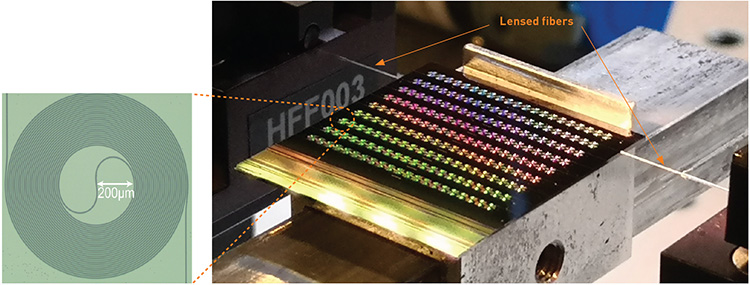 Left: A single low-loss dispersion-engineered silicon-nitride spiral waveguide. Right: Nine parametric amplifiers on a single chip, each a concatenation of 21 spirals.
Left: A single low-loss dispersion-engineered silicon-nitride spiral waveguide. Right: Nine parametric amplifiers on a single chip, each a concatenation of 21 spirals.
Optical amplifiers are essential in numerous photonics applications. Parametric amplifiers, relying on a nonlinear material to create amplification, are unique, as they can amplify without generating excess noise if operated in phase-sensitive mode. That makes them, in principle, capable of a 0 dB noise figure,1 in contrast to all other known optical amplifiers, which have a quantum-limited noise figure of 3 dB.
In recent decades, numerous publications have presented efforts by leading research groups2 toward experimental demonstration of continuous-wave (CW) operation of parametric amplification in third-order-nonlinearity (χ(3)) waveguide platforms. A significant challenge relates to both the linear and the nonlinear losses suffered by such waveguides. As a result, demonstrations thus far have used only a pulsed pump wave rather than a CW pump wave—a prerequisite for practical use. Nevertheless, this type of amplifier promises not only to be potentially very compact, but also to be capable of a broad spectral gain in different wavelength ranges. In addition, aside from amplification, these devices are capable of other functionalities ranging from wavelength conversion to optical squeezing.
To overcome current limitations, we have developed a compact, very-low-loss and dispersion-engineered silicon nitride waveguide platform that has demonstrated amplification based on the third-order nonlinearity in a single chip.3 The concatenation of 21 spiral waveguides forms a 1.4-m-long nonlinear waveguide in a compact format, with a loss of 1.4 dB/m. With these devices, we were able to demonstrate the first CW operation of compact single-chip parametric amplifiers. These amplifiers were evaluated both in phase-insensitive and phase-sensitive mode. The observed chip gain was up to 10 dB, while the measured chip noise figure in phase-sensitive mode was as low as 1.2 dB.
We believe that these results are significant. They clearly represent the first such CW mode demonstration, with a very small noise figure. They also show a realistic path toward fabricating the devices for practical use as compact amplifiers in a variety of applications, ranging from telecom, lidar and signal processing to spectroscopy.
Researchers
Zhichao Ye, Ping Zhao, Krishna Twayana, Magnus Karlsson, Victor Torres-Company and Peter A. Andrekson, Chalmers University of Technology, Gothenburg, Sweden
References
1. C.M. Caves. Phys. Rev. D 26, 1817 (1982).
2. M.A. Foster et al. Nature 441, 960 (2006).
3. Z. Ye et al. Sci. Adv. 7, eabi8150 (2021).
